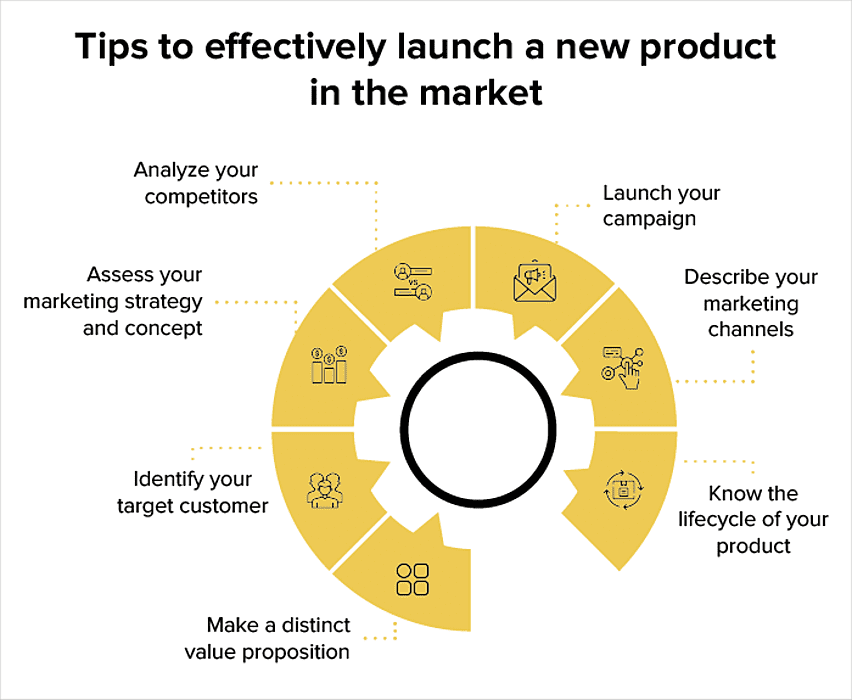
When it comes to marketing new products or services for your business, there may appear to be countless options. It can be difficult to decide where to start and how to launch a new product to yield the best results.
There are a variety of free ways to market your business, and which ones are most effective depends on your industry, product line, and target market.
However, a few universal traits are present in all marketing strategies for growth that anyone can employ. So, in this article, we'll talk about marketing tips for launching a new product. We'll also talk about the challenges with new launches and how to deal with them. Let's begin!
Effective Marketing Tips for a New Product Launch
Here is a list of tips you should keep in mind when you launch a new product marketing plan.

1. Make a distinct value proposition
Firstly, while marketing a new product, you ought to be fully aware of what you must provide. This will help you distinguish yourself from your rivals and who will be interested in taking advantage of your offer. But do you understand why clients would choose to purchase from you instead of the wide range of competitors out there? Which features and benefits do you think your potential clients would value most from your offering? The bottom line is that your "bundle" of products or services should be distinctive and catered to your top prospects' wants and needs.
2. Identify your target customer
Focusing solely on the customers you believe are most likely to make a purchase from you will be crucial for a successful launch of your new product or service with the least amount of financial investment. These customers can be those who have already purchased similar items and will value the extra benefits your new offering offers. Your strongest prospects are those who believe they require what you have to offer, can pay for it, and have already shown that they are willing to acquire it—probably by doing business with one of your rivals. Remember that it is usually simpler to meet an existing demand than to create one.
3. Assess your marketing strategy and concept
Rushing blindly into the launch phase without testing is reckless, given the amount of money it requires to introduce a new product or service to the market. What ought to be tested? It's best to review your entire product or service offering, in addition to your brand communication and materials. You can do formal focus groups (or simply hold roundtable conversations with members of the target demographic), use web research or mall intercept research, or give your product to a small group of consumers for testing, depending on what you want to sell and your budget. You shouldn't start creating your marketing tools and content until all testing is done.
4. Analyze your competitors
Participants in many corporate marketing courses learn how to conduct a SWOT analysis (strengths, weaknesses, opportunities, and threats). You must begin by paying close attention to your rivals. Make a list of the companies that provide goods or services comparable to the one you intend to offer. Even if you believe your new product or service is completely original and has no rivals, it's still a good idea to put yourself in the position of your potential clients and consider what they might purchase in place of what you intend to give.
Review their marketing collateral, such as their advertising, brochures, and websites, once you've decided who your competition will be. Consider how your new offering will compare to what is presently available, where you will shine, and which businesses or their products pose the greatest challenges to your success.
5. Launch your campaign
Public relations frequently play an important part in introducing a good or service. You can gain coverage by enabling influential media to evaluate your product, hosting a promotional event, or using grassroots marketing to generate buzz. You can use media relations strategies to place stories and land interviews.
However, in order to get the most out of the attention you receive, regardless of the publicity strategy you select, you must first ensure your service or product is entirely ready and accessible for purchase. And your other promotional strategies ought to start right after your press release. Keep an eye on the outcomes from all media, and be ready to modify your strategy in the early weeks and months to capitalize on what's performing well.
6. Describe your marketing channels
Select your marketing and sales channels next. Will you, for instance, market through a catalog, market online, or through retailers? As your main channels, you may decide to use both traditional direct marketing as well as online sales. Since clients who can shop whenever and however they want are more likely to spend more money and shop more frequently, multichannel marketers typically have the most success.
Consider that your marketing plan is to sell cheap exercise equipment to customers who cannot afford expensive home gym equipment or club memberships. You will then use strategies like direct-response TV advertisements, internet ads, and email solicitations with links to your website.
7. Know the lifecycle of your product
As your service or product develops, the campaign you used during the introduction, as well as the instruction phase of the launch, needs to be updated. When it's time to change the product or service, your media strategy should also change. Or you could even phase out this specific offering and start laying the basis for introducing your next big concept; you'll be able to tell since you'll be closely watching your marketing outcomes.
Marketing challenges that you can face in launching a new product

1. Launching challenges
No matter how great your new product is, it won't be a market success until your new product launch marketing plan is effective. If you don't showcase your product to the consumers, how will they purchase them? The most crucial question is how you'll persuade them to buy your new goods.
However, the easiest approach to deal with this issue is to publicize the launch. Utilizing the best channel to reach your target market, revealing just enough details to pique interest, and keeping your audience updated on your progress will all contribute to successfully marketing your product launch. But doing this presents significant difficulties for the majority of businesses.
Solution
There are several ways to market your product launch such that it creates enough buzz for it to be successful. The first and most important step is utilizing the appropriate platform for your product launch promotion. The idea is to sell it on the site where your target market hangs out.
For instance, if professionals make up your target market, you should utilize Linkedin. If you're marketing to millennials, you should use Snapchat, Instagram, or Youtube. If you're marketing to the general public, you should use television and print advertisements. You can run a contest, organize a teaser campaign, or employ influencer marketing.
2. Lack of proper targeting of audience
Identifying your target audience using stereotypes is simple, although not ideal. It's dangerous to make assumptions about the demographics of potential customers for your product. Launching a new product without first doing some quick market research on your target market is not a good idea. If you don't do adequate research, you'll only end up choosing the wrong group to target and lose out on a potential customer base.
Solution
You must conduct appropriate audience and market research to identify the most pertinent target audience. Investigate the racial and ethnic groups that search the most for the category in which your product is classified. Figure out which social media site this particular demographic uses the most, as well as the kind of content they enjoy, by conducting further research.
Before launching your new product, you may conduct better market and consumer research using a variety of tools, both free and commercial. These tools can help you learn vital consumer trends, demographic preferences, and shopping habits. You can then use this information to identify your target market and advertise your new product.
3. Lack of proper brand positioning
After your new product has been created, the first difficulty is persuading buyers that they require your goods. The majority of businesses struggle to communicate with their target market in a way that connects with them. They fail to choose the proper brand strategy used to launch new products and properly position their new product. Ultimately, they are unsuccessful in selling their new product.
Solution
Even though you want to sell your goods, your language and positioning should focus on your target audience rather than your brand or product. Need to highlight the fantastic qualities of your new product? Describe the advantages these features will have for your audience. You won't have any trouble effectively conveying your message if you make it focused on the audience.
While dealing with the strategies for marketing a product, start by concentrating on one key target demographic. Even though you may be aiming for several different demographics at once, you should choose the one that will need and value your product the most. This can assist you in coming up with a promotional strategy that is effective.
Determine the issues that your target market faces and how your product can address them. Then, based on the information you've obtained, you may design your brand messaging and product positioning.
Conclusion
A marketing plan for a new product launch entails a lot of complexities. The channels your target uses and their online habits will determine the best strategy for marketing new products or services. Regardless, you ought to cross-promote and leverage several channels while you are implementing marketing strategies for the new product. You may anticipate higher levels of interaction as your messaging becomes more unified and consistent and as your audience becomes more familiar with it. You should invest time and resources in promoting the new product by advertising the new product effectively. You can even contact top app marketing agencies to help you facilitate the process of your product launching strategy. To attain the outcomes you desire from your upcoming product launch, try out the marketing tips for the new products mentioned above.















